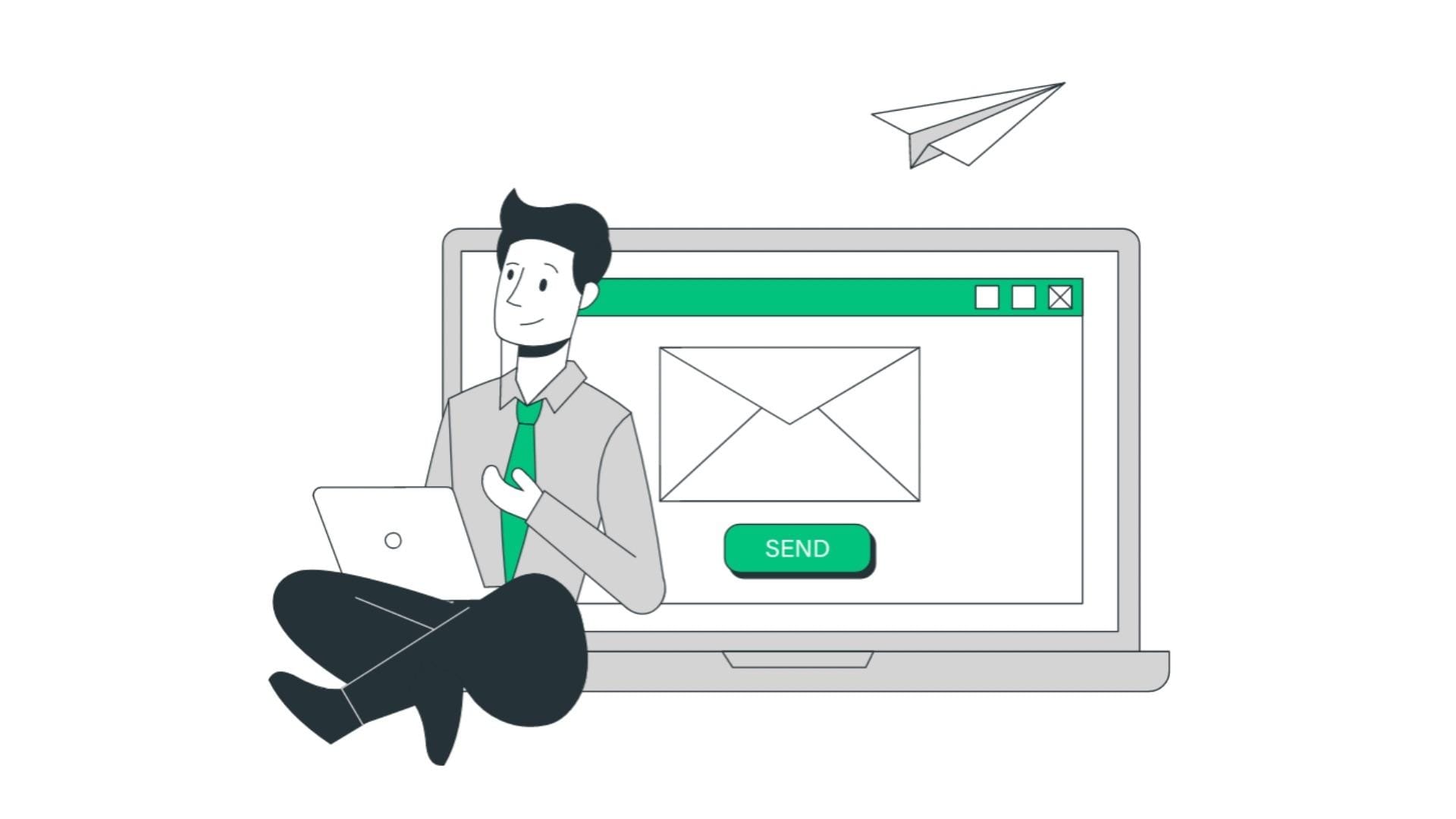How to Automate Email Sending? Beginner's Guide and Tips
Discover tips to automate emails, their benefits, and how to implement the tips for your business. Read on to find out!

So, you’ve heard about email automation and how it can save you time, but you’re not sure where to start?
No worries, you’re in the right place. Automating your emails doesn’t have to be complicated—it’s actually pretty simple once you get the hang of it.
Email automation is essentially setting up a system where emails are sent out automatically based on triggers, like actions or timeframes, so you don’t have to do it manually.
Email communication remains a preferred method for many businesses, yet many have not fully harnessed the potential of email automation to improve customer interaction and engagement.
In this beginner’s guide, we’re going to walk you through the basics of automating your emails. We’ll cover everything from tips and tracks to How to implement email automation. This will help you make sure your emails are hitting the right notes with your audience.
How to Start Automating Emails
Ready to take the plunge and start automating your emails? It’s easier than you might think! Email automation can save you time, help you maintain consistent communication with your audience, and improve your overall marketing efforts. Follow these detailed steps to set things up:
1. Sign Up and Set Up Your Account
The first step in automating your emails is selecting an email automation platform that fits your business needs. Popular options include Mailchimp, ActiveCampaign, and HubSpot. Each of these platforms offers a variety of features tailored to different business sizes, industries, and goals, so it’s important to choose one that works best for you.
- Create Your Account: Sign up with your business email and create an account on the platform of your choice.
- Business Information: Fill in essential details like your company name, address, and branding info (logo, colors, etc.). This ensures that your emails are aligned with your business identity and comply with regulations like the CAN-SPAM Act.
- Email Preferences: Customize your email preferences such as your sending time zone, email signature, and the default sender name for your emails. You can also integrate your account with other tools or software you’re using, like CRMs or e-commerce platforms, to make your workflow more seamless.
2. Create and Segment Your Contact List
The heart of email automation lies in having a well-organized and properly segmented contact list. Segmenting your contacts allows you to send tailored content that resonates with specific groups of subscribers. Without segmentation, your messages may seem too generic, reducing engagement and conversions.
- Organize Your Contacts: Upload your contact list into the platform and categorize them based on various factors such as:
- Demographics: Age, location, job title, etc.
- Purchase History: Customers who’ve bought from you before vs. those who haven’t.
- Engagement Level: New subscribers, active customers, or inactive subscribers.
- Create Segments: Most platforms allow you to create segments based on custom fields or actions (e.g., people who clicked on a specific product link or abandoned their cart). These segments ensure that you send the right message to the right person at the right time.
By segmenting your list, you’re able to create personalized campaigns that speak directly to each group’s interests and needs.
3. Design Your Email Using Templates
Most email automation platforms offer a variety of pre-designed templates that are mobile-responsive and ready for customization. Using a template saves you time and ensures that your emails are visually appealing and functional across all devices.
- Choose a Template: Select a template that matches your brand’s style and the goal of your email. Templates are often categorized by type (e.g., welcome emails, promotional emails, or newsletters).
- Customize the Design: Make the template your own by adding your branding elements like your logo, color scheme, and fonts. Most platforms let you drag and drop elements into the email, so you don’t need coding skills.
- Mobile-Friendly Design: Ensure that your email looks great on mobile. With more people reading emails on their phones, it’s crucial to make sure your email adjusts to different screen sizes. A mobile-optimized email boosts open rates and engagement.
- Content and Personalization: Personalize your emails by adding dynamic fields such as the recipient’s name, company name, or last purchase. This helps create a more personal connection with your audience, even though the email is automated.
4. Define Triggers and Workflows
Triggers and workflows are the backbone of your email automation. A trigger is an action or event that sets off an automated email. For example, when a new subscriber joins your mailing list, they might receive a welcome email right away. Workflows, on the other hand, are a series of actions that are triggered in sequence based on specific criteria.
- Identify Key Triggers: Think about what events in your business should automatically trigger an email. Some common triggers include:
- Sign-Ups: When someone joins your newsletter or creates an account.
- Purchases: After a customer buys a product, send them a thank-you email or related product recommendations.
- Abandoned Carts: If a customer adds items to their cart but doesn’t complete the purchase, trigger a reminder email.
- Inactive Subscribers: If someone hasn’t engaged with your emails in a while, set up a re-engagement campaign.
- Create Workflows: Workflows are a series of automated steps that lead the recipient through a customer journey. For example, a welcome workflow could include:
- Step 1: Welcome email with an introductory message.
- Step 2: Follow-up email with a helpful guide or a special offer.
- Step 3: Reminder email for the special offer or a product suggestion.
Once you’ve set the triggers and workflows, sit back and watch the automation do the work for you! Now that your automation system is in place, let’s look at how you can leverage email automation to strengthen customer relationships, increase retention, and boost sales.
Also Read: Transforming Sales Enablement with AI: Use Cases and Future Impact.
Implementing Email Automation for Business Growth
Email automation isn’t just about saving time—it’s also a powerful tool for driving business growth. Here’s how email automation can contribute to your business’s success:
1. Opportunities with Personalization
Personalization goes beyond just adding a recipient’s name in the subject line. With email automation, you can personalize content based on individual behaviors, preferences, or demographics. Personalized emails are significantly more likely to be opened, read, and acted upon.
- Behavior-Based Personalization: Send emails based on actions your contacts take, such as:
- If they browse specific products on your site, you can send them a follow-up email showcasing those products or similar ones.
- If a customer frequently buys from a particular category, you can send them targeted offers or discounts related to that category.
- Dynamic Content: Many email platforms allow you to insert dynamic content, where parts of the email change based on the recipient’s information (e.g., showing different product recommendations for different segments).
By tailoring your emails to individual behaviors, you’re more likely to engage your audience and increase conversion rates.
2. Strategies for Customer Retention
Email automation can be used to strengthen customer relationships by providing value and maintaining consistent communication. Retaining customers is often more cost-effective than acquiring new ones, and email is a great way to keep your customers coming back for more.
- Nurturing Sequences: Set up automated sequences that deliver value over time, like a series of helpful tips or tutorials that help customers get the most out of your product or service.
- Exclusive Offers and Rewards: Reward loyal customers with exclusive deals, early access to new products, or special discounts. Automated emails can trigger these offers at specific milestones, such as anniversaries or birthdays.
- Customer Feedback and Engagement: Use email automation to collect feedback from customers post-purchase. This shows customers that you value their opinions and gives you insights into how you can improve.
3. Enhancing Team Efficiency Through Automation
One of the best things about email automation is how it frees up your team’s time. By automating repetitive tasks, your team can focus on more strategic activities, like content creation, campaign optimization, or customer support.
- Reduced Manual Work: With automation handling follow-ups, welcome emails, and cart reminders, your team won’t have to spend time manually sending messages.
- Better Reporting: Email automation platforms provide detailed reports that show how your emails are performing. Your team can easily track open rates, click-through rates, and conversions, helping them make data-driven decisions.
- Scalability: As your business grows, manually handling emails becomes unsustainable. Automation scales with you, ensuring that your communication remains consistent and timely, even as your contact list expands.
By following these steps and implementing email automation effectively, you can unlock the full potential of your email campaigns, driving better engagement, higher sales, and stronger relationships with your customers.
While it's easy to automate email, making it effective requires a little strategy.
Helpful Read: Calculating and Boosting Email Engagement: Strategies and Best Practices
Tips for Effective Email Automation
While it's easy to automate email, making it effective requires a little strategy. Here are some top tips for success:
Keep Your Emails Simple and Clear
Automated emails work best when they’re straightforward. Instead of cramming in too much info, aim for clarity. Use simple language, break up text for easy scanning, and make sure your call-to-action stands out. The goal is to guide your reader to the next step—whether that’s booking a demo, replying, or downloading something—without making them dig through a wall of text.
Define Your Email Triggers
Essentially, a triggered email is an automatic message that gets sent based on a specific action or event. For example, if someone signs up for your newsletter, they might automatically get a welcome email right away.
You can set up an automated reminder email that nudges them to complete the steps. Or if someone makes a purchase, you can send them a thank-you email, then follow up with product recommendations.
Triggers can be based on:
- User actions (e.g., signups, purchases)
- Specific dates (e.g., anniversaries, birthdays)
- Behavioral data (e.g., browsing activity)
Set Up Your Email Sequences
It's also important to think about the follow-up emails after you send your first one. This is where you get to build out your email sequences. For example, if someone signs up for a free trial, you can set up a sequence that includes a welcome email, then follow up with some helpful tips, and finally, a “don’t miss out” email before the trial expires.
Test Your Emails Before Going Live
It’s not just about typos—testing your email sequences helps catch broken links, faulty personalization, awkward formatting, or emails being sent at the wrong stage of the funnel. A quick test run can save your team from embarrassing slip-ups and help make sure each message lands exactly how and when it should.
Don't Automate Email Too Much
Automation should make your emails more consistent, not impersonal. Bombarding leads with too many templated emails can do more harm than good, leading to disengagement or unsubscribes. Instead, use automation to deliver timely, relevant messages—then layer in human touchpoints where they matter most, like follow-ups or replies. Keep the focus on quality and timing, not just volume.
Optimize Email Timing
Even the best email won’t do much if it’s sent at the wrong time. For example, if someone abandons their cart on your site, it’s crucial to follow up quickly—within 24 hours—to remind them about what they left behind. Similarly, welcome emails should go out immediately after someone signs up, so they don’t forget why they joined in the first place.
Also Read: To know about the Best Reply Automation Software in 2024
With these strategies in place, let's now look at some practical examples of email automation that demonstrate how these tips can enhance your campaigns.
Practical Email Automation Examples
Here are some key email automation examples that can make your life a lot easier:
1. Welcome Emails
As soon as someone signs up or joins your list, send them a warm, automated welcome email. It’s a great way to introduce your brand, set expectations, and even offer a discount or special deal to kick things off.
2. Abandoned Cart Emails
When a potential customer adds items to their cart but doesn’t complete the purchase, automated emails can remind them. You can even add an incentive like a discount to encourage them to finalize the order. These emails usually have high conversion rates because they target interested customers.
3. Birthday Emails
Everyone loves a little surprise, especially on their birthday. With automation, you can set up a personalized birthday email with a special offer or a gift. It’s a simple way to make customers feel valued and build loyalty.
4. Post-Purchase Follow-ups
After someone makes a purchase, automate a follow-up email to thank them and ask for feedback. You can also suggest related products based on what they bought, which helps with cross-selling.
5. Re-engagement Emails
If you’ve got inactive subscribers or customers who haven’t interacted in a while, automated re-engagement emails can bring them back. These emails might offer a discount or remind them of the benefits of staying connected.
6. Drip Campaigns
Set up a series of automated emails that nurture leads over time. Whether it’s educating them about your product, offering tips, or sharing case studies, drip campaigns keep your audience engaged and move them through the sales funnel at their own pace.
Now that you’ve seen some practical examples of email automation, let’s explore the key benefits it offers to your business, from saving time to boosting engagement and revenue.
Bonus Read: Best Cold Email Outreach Techniques for Startups: 2025 Guide
Benefits of Email Automation
Let’s talk about something you’ve probably thought about at least once—how much time would you save if you didn’t have to sit down and manually send emails all day? Email is still a major player in the digital world. In fact, it’s growing, not shrinking.
It is expected that the global number of email users is projected to hit 4.6 billion in 2025—an increase of about 600 million from the 4 billion users in 2020.
Source: Link
Here’s why automating your emails makes sense:
- Save Time: Instead of sending the same email over and over, set it up once and let automation do the work for you.
- Stay Consistent: With automation, you never have to worry about missing a message. Your audience gets the right content at the right time.
- Better Engagement: Automated emails can be personalized, so you’re sending content that speaks directly to your audience, which leads to better responses and higher conversions.
- Scale Easily: As your business grows, handling emails manually gets tough. Automation helps you scale without adding extra stress.
- Enhance Customer Experience: Automated emails allow you to respond instantly to customer actions, improving their experience and satisfaction.
- Personalized Communication: With automation, you can segment your audience and send relevant messages tailored to their needs.
- Boost Revenue Potential: Triggered emails, such as abandoned cart reminders, drive more conversions and increase sales.
- Improved Tracking: Gain valuable insights from automated reports, helping you understand customer preferences and improve campaigns.
Email automation streamlines your processes, helping you save time, stay consistent, and engage more effectively with your audience. It’s a powerful tool for scaling your business while improving both efficiency and customer experience.
Conclusion
So here’s the bottom line: Email automation is a game changer. It takes those repetitive, time-consuming tasks off your plate—like sending follow-ups, welcome emails, or reminders—and does them for you. This means you can finally stop stressing over every little email and instead focus on bigger goals like growing your business.
Plus, by automating these messages, you get more consistency, better engagement with your audience, and, best of all, a boost in conversions. It’s all about working smarter, not harder. The time you save can go toward more creative and strategic efforts that actually move the needle.
Floworks’ Alisha AI SDR makes email automation simple and effective. It personalizes outreach and keeps your leads engaged, helping you scale effortlessly. If you’re ready to streamline your sales process and drive growth, Floworks can help you achieve your goals.
Get started with Floworks today and watch your business grow with every automated email! Contact us now!
FAQs
- How do I set up automatic email sending?
You can set up automatic email sending using email automation tools like Alisha AI SDR, Mailchimp, HubSpot, or ActiveCampaign. These platforms allow you to create emails and schedule/send them based on triggers or preset times. The setup usually involves creating a workflow or automation sequence.
- What is email automation strategy?
An email automation strategy is a plan for sending targeted, personalized emails automatically based on user actions or predefined triggers. It aims to streamline communication, nurture leads, and improve engagement by delivering the right content at the right time.
- What is the best language for email automation?
The best language for email automation often depends on the tool or platform you're using, but common languages include Python for scripting or built-in automation tools with drag-and-drop functionality. For most platforms, no coding is required, as they offer easy-to-use interfaces.
- What is the automation of emails called?
The automation of emails is typically referred to as "email automation" or "automated email marketing." It uses software to automatically send emails based on triggers, schedules, or specific user interactions, helping streamline email marketing automation and communication efforts.


